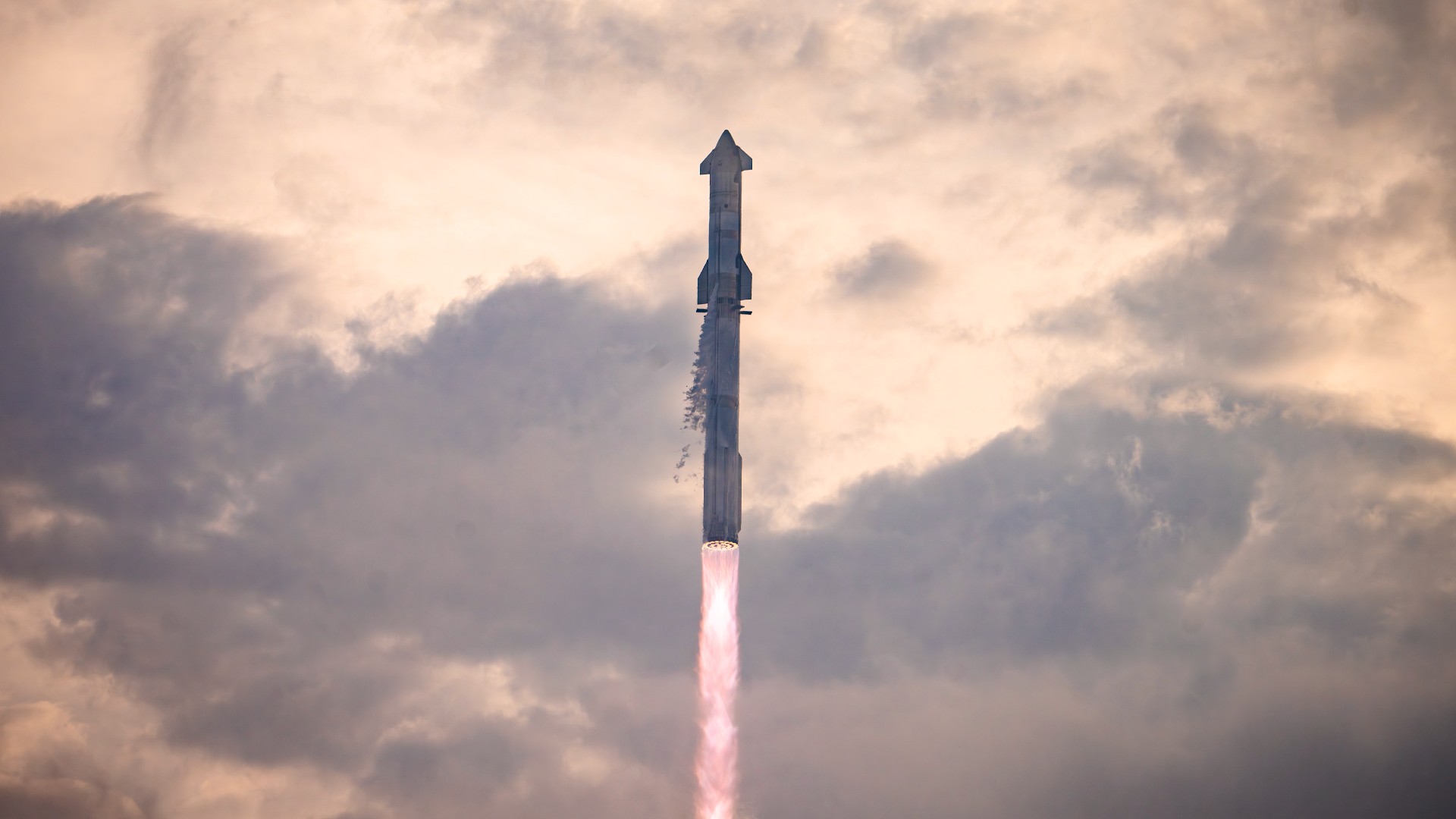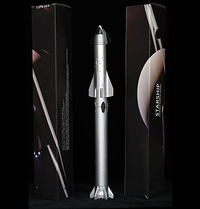
The launch of a 400-foot-tall (122 meters) rocket won't seem like a novelty for much longer.
SpaceX's giant Starship vehicle lifted off for the third time ever today (March 14) on an ambitious test flight that energized space fans around the world.
Starship didn't achieve all of its goals today; both its first-stage booster, known as Super Heavy, and its upper-stage spacecraft were lost as they came back to Earth, for example. But the megarocket flew faster, farther and longer than it had before, cheering the company and NASA, whose Artemis program will use Starship to land astronauts on the moon.
"Congrats to @SpaceX on a successful test flight! Starship has soared into the heavens. Together, we are making great strides through Artemis to return humanity to the moon — then look onward to Mars," NASA chief Bill Nelson said via X today.
Related: SpaceX launches giant Starship rocket into space on epic 3rd test flight (video)
Read more: Relive SpaceX Starship's 3rd flight test in breathtaking photos
Starship's first crewed moon landing for NASA is scheduled to take place in September 2026, on the agency's Artemis 3 mission. Getting Starship up and running in time to meet that deadline will require a lot of work — and SpaceX has rolled up its sleeves.
The company has already built four more Starships at its Starbase facility in South Texas, which hosted today's launch.
Get the Space.com Newsletter
Breaking space news, the latest updates on rocket launches, skywatching events and more!
"These vehicles are slated for future flight tests just like today's," Siva Bharadvaj, a space operations engineer at SpaceX, said during a webcast of today's launch.
"And, in fact, just this week, we static-fired our next ship that's planning to fly and expect to test the booster as soon as the launch mount is free from today's flight test," he added.
SpaceX will aim to get these and future vehicles aloft as quickly as possible, in keeping with the company's "build, fly and iterate" philosophy. Indeed, SpaceX founder and CEO Elon Musk said this week that the company hopes to launch at least six Starship missions in 2024.
Musk is known for his aggressive timelines, but that one may well be achievable. Seven months elapsed between the first Starship test flight, in April 2023, and the second, which occurred this past November. The gap between flight two and today's launch was just four months, so things are moving in the right direction.
And the turnaround for flight four should be shorter still, given the milestones notched on today's mission. For instance, Super Heavy performed a successful "boostback burn" after separating from the upper stage, getting itself into position for a splashdown in the Gulf of Mexico (though it did not ace its landing burn).
And the upper stage reached orbital velocity, opened its payload door in space as it will do on operational, satellite-deploying flights, and survived reentry into Earth's atmosphere for a while. The ship managed to beam home incredible video of its fiery ordeal before going dark about 50 minutes after liftoff. (Starship flights one and two lasted just four minutes and eight minutes, respectively.)
Related: See stunning photos and video of Starship's 2nd launch
Starship Die Cast Rocket Model Now $69.99 on Amazon.
If you can't see SpaceX's Starship in person, you can score a model of your own. Standing at 13.77 inches (35 cm), this is a 1:375 ratio of SpaceX's Starship as a desktop model. The materials here are alloy steel and it weighs just 225g.
Note: Stock is low so you'll have to act quickly to get this.
And Starship's flight cadence will likely ramp up greatly after it becomes operational. For example, before each moon-landing mission, Starship will need to top up its tanks at a propellant depot in Earth orbit.
It will take multiple Starship "tanker" missions to fill this depot. How many is a matter of debate, due partly to the uncertainty about how much of the supercold propellant will "boil off." Musk has pegged the number of tanker flights per Starship lunar landing at four to eight, whereas NASA officials have said it could be "in the high teens." No matter what the final number turns out to be, that's a lot of Starship launches.
SpaceX also plans to use Starship to help humanity settle Mars, as Musk has repeatedly stressed (including in the aftermath of today's flight). Setting up a sustainable city on the Red Planet would require a staggering number of launches, even though Starship is the most powerful rocket ever built. (In its final form, Starship will be capable of hauling up to 275 tons to Earth orbit, Bharadvaj said during today's webcast.)
To give you an idea: A few years back, Musk laid out a plan that involved launching fleets of 1,000 Starships to the Red Planet every 26 months, the recurring window when Earth and Mars align properly for interplanetary missions.
That may be overly ambitious or, if achievable, a nod to a far-off future. But it's safe to assume that we'll have plenty more chances to watch the fledgling Starship fly over the coming months.
Join our Space Forums to keep talking space on the latest missions, night sky and more! And if you have a news tip, correction or comment, let us know at: community@space.com.

Michael Wall is a Senior Space Writer with Space.com and joined the team in 2010. He primarily covers exoplanets, spaceflight and military space, but has been known to dabble in the space art beat. His book about the search for alien life, "Out There," was published on Nov. 13, 2018. Before becoming a science writer, Michael worked as a herpetologist and wildlife biologist. He has a Ph.D. in evolutionary biology from the University of Sydney, Australia, a bachelor's degree from the University of Arizona, and a graduate certificate in science writing from the University of California, Santa Cruz. To find out what his latest project is, you can follow Michael on Twitter.
-
Philly I am not hoping for any other aerospace company to fail but it would seem like expecting another rocket to magically work perfectly on it's 1st launch, seems to be delusional thinking. Considering BO has never put a single Kg into orbit, it really is kind of crazy thinking. They don't even know what they don't know yet. Every month they delay flying test flights only is putting them further behind by years if not decades. It is the old story of the tortuous and the hare.Reply
Yes you can point to the SLS and say it worked perfectly the 1st time. Also consider it was almost based all on Shuttle tech that flew over 100 times. Considering it is a throw away rocket, how much did it really push forward with new tech? When you consider the costs, yes it worked but this isn't a path forward beyond maybe 1 flight per year. It isn't powerful enough to put Orion into Lunar Orbit. Not sure what anyone was thinking besides creating jobs for key congressional districts.
The SX Starship system once operational will be a huge game changer. Getting 100+ tons to the Moon or Mars requires orbital refueling. This is just basic physics. NOT an optional choice that can somehow be ignored just because you don't want to hear it. People are complaining that the SX lunar lander is too complex and would require too many flights. You're debating physics and not accepting reality.
Apollo was awesome, but it was a small weekend camper to the surface. Take a few selfies, plant a flag and grab a few rocks. There was no way to build more off of that tech. You couldn't build a Moon base with that limited tech. It was the real problem NASA faced in 1972. Why make the same mistake again in 2024? You're going to need to place hundreds of tons of equipment on the moon, to build a moon base. That will also require lots of low tech things like food, fuel and water. Not exactly ideal things to put on a $3 billion rocket that you'll throw away after every launch, that is some expensive toilet water.
The great space powers in 25-50 years will be the nations who can build fuel stations on the moon. Water at the South pole will be critical. Be the 1st one there and it is you're to claim, like it or not. We'll be able to get much more fuel off of the surface of the moon in less flights than trying to fly it up from Earth. -
Unclear Engineer I agree that SpaceX is developing the logical engineering designs for creating an actual long-term habitat on the Moon.Reply
I am not so sure that moon habitats will eventually become rocket propellant manufacturing sites. It will depend on how much water is actually on the Moon and how easily it can be extracted from wherever it is, there. So, I would not be making any commercial bets on that, with what we currently know.
But, the Moon bases will definitely have scientific tasks, particularly astronomy and maybe some physics experiments. I doubt it will have much strategic military value for conflicts on Earth, due to its distance and its limited periods of view for specific locations on Earth.
I doubt it will become a tourist mecca or a colony for people who just want to get off Earth for "a better place to live".
But, who really knows the future? Some major breakthrough in our understanding of physics and/or the universe might have benefits we cannot predict, today. But, we really can't count on that. We have to plan and design on the basis of what we know today about what is possible with what we currently understand.










